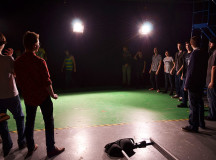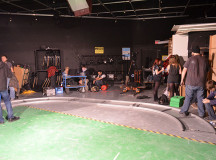Media Arts does the mosh for documentary
STORY AND PHOTOS BY TYLER REYNOLDS
When most people think of moshing, they think of a group of angry people beating each other up.
Two Media Arts students from Sheridan College have started a controlled mosh pit for a documentary they are filming to end some of these misconceptions.
The controlled mosh pit is a part of a documentary called Battles and Brotherhood, the name from the Canadian metal band 3 Inches of Blood. It is being put together by two third-year Media Arts students, director Dziewanna Picazo and producer Raychel Reimer.
“Well, personally as a mosher, I always get the same question: Why would you mosh,” says Picazo. “When people ask me why, it’s always the same and I can’t really explain it, so I thought I’d do a documentary on it.”
Moshing, formerly known as slamdancing, is a form of dance where people push or slam into each other to live aggressive music.
Not looking like “typical” moshers, Picazo and Reimer have shocked others with their preference in music.
“We both listen to harder music, and we’re both into more of the metal scene,” says Picazo. “People find it very surprising, especially once you talk to us or look at us. People don’t think that we would be involved in that sort of scene, and I find that it’s the same for pretty much everybody that moshes.”
The documentary addresses the stigma behind moshing.
“I think a lot of the time there’s misconceptions about mosh pits,” says Reimer. “That the people who participate in them are really aggressive and uncontrollable. We wanted to take a look more towards why this is.”
Picazo and Reimer not only have focused on concert goers, but also have taken a look at the scientific side of the topic.
“We’re looking at it at scientifically as well,” says Reimer. “We interviewed behavioral therapists, a physics major, and someone who’s your typical mosher, so someone who’s interested in science could be interested in the documentary.”
People who have enjoyed moshing for years seem to enjoy the controlled mosh pit.
“I think I started in high school, around Grade 10,” says first year Media Arts student Steven Patoine. “Being in a fake mosh pit is a ton of fun because I don’t really have time to go to real ones these days.”
Despite the apparent misconceptions and stigma behind moshing, Picazo still feels that there’s something more to it.
“There’s a lot of people who are in this sort of culture and this kind of scene that have been doing it for years,” says Picazo. “Now they’re business professionals or researchers or, teachers, and it’s their way of getting their aggression out in a safe environment. It goes so much deeper than a bunch of punk kids punching each other in the face.”
[box style=”rounded”]More from The Sheridan Sun
[unordered_list style=”arrow”]
[/unordered_list]
[/box]










